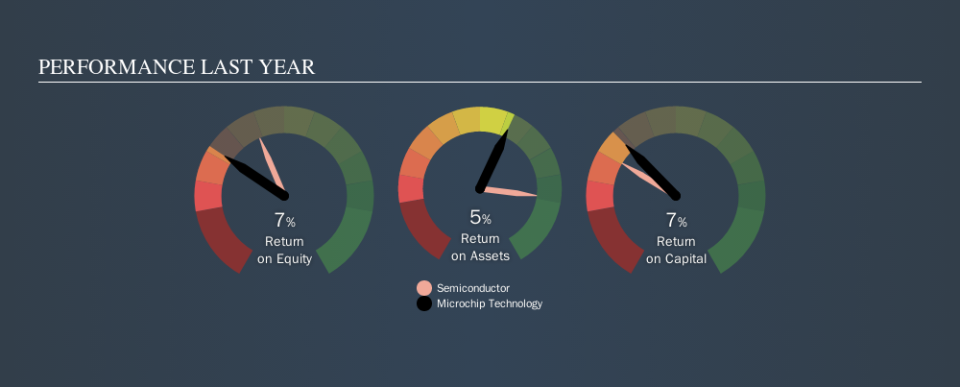How Do Microchip Technology Incorporated’s (NASDAQ:MCHP) Returns On Capital Compare To Peers?

Today we'll look at Microchip Technology Incorporated (NASDAQ:MCHP) and reflect on its potential as an investment. Specifically, we're going to calculate its Return On Capital Employed (ROCE), in the hopes of getting some insight into the business.
Firstly, we'll go over how we calculate ROCE. Next, we'll compare it to others in its industry. Finally, we'll look at how its current liabilities affect its ROCE.
Return On Capital Employed (ROCE): What is it?
ROCE measures the 'return' (pre-tax profit) a company generates from capital employed in its business. Generally speaking a higher ROCE is better. Overall, it is a valuable metric that has its flaws. Renowned investment researcher Michael Mauboussin has suggested that a high ROCE can indicate that 'one dollar invested in the company generates value of more than one dollar'.
How Do You Calculate Return On Capital Employed?
Analysts use this formula to calculate return on capital employed:
Return on Capital Employed = Earnings Before Interest and Tax (EBIT) ÷ (Total Assets - Current Liabilities)
Or for Microchip Technology:
0.067 = US$1.1b ÷ (US$18b - US$2.5b) (Based on the trailing twelve months to June 2019.)
Therefore, Microchip Technology has an ROCE of 6.7%.
See our latest analysis for Microchip Technology
Does Microchip Technology Have A Good ROCE?
One way to assess ROCE is to compare similar companies. Using our data, Microchip Technology's ROCE appears to be significantly below the 10% average in the Semiconductor industry. This performance could be negative if sustained, as it suggests the business may underperform its industry. Separate from how Microchip Technology stacks up against its industry, its ROCE in absolute terms is mediocre; relative to the returns on government bonds. It is possible that there are more rewarding investments out there.
Our data shows that Microchip Technology currently has an ROCE of 6.7%, compared to its ROCE of 5.0% 3 years ago. This makes us wonder if the company is improving. You can click on the image below to see (in greater detail) how Microchip Technology's past growth compares to other companies.
When considering ROCE, bear in mind that it reflects the past and does not necessarily predict the future. ROCE can be misleading for companies in cyclical industries, with returns looking impressive during the boom times, but very weak during the busts. ROCE is only a point-in-time measure. What happens in the future is pretty important for investors, so we have prepared a free report on analyst forecasts for Microchip Technology.
What Are Current Liabilities, And How Do They Affect Microchip Technology's ROCE?
Short term (or current) liabilities, are things like supplier invoices, overdrafts, or tax bills that need to be paid within 12 months. Due to the way ROCE is calculated, a high level of current liabilities makes a company look as though it has less capital employed, and thus can (sometimes unfairly) boost the ROCE. To check the impact of this, we calculate if a company has high current liabilities relative to its total assets.
Microchip Technology has total liabilities of US$2.5b and total assets of US$18b. As a result, its current liabilities are equal to approximately 13% of its total assets. This very reasonable level of current liabilities would not boost the ROCE by much.
Our Take On Microchip Technology's ROCE
That said, Microchip Technology's ROCE is mediocre, there may be more attractive investments around. But note: make sure you look for a great company, not just the first idea you come across. So take a peek at this free list of interesting companies with strong recent earnings growth (and a P/E ratio below 20).
For those who like to find winning investments this free list of growing companies with recent insider purchasing, could be just the ticket.
We aim to bring you long-term focused research analysis driven by fundamental data. Note that our analysis may not factor in the latest price-sensitive company announcements or qualitative material.
If you spot an error that warrants correction, please contact the editor at editorial-team@simplywallst.com. This article by Simply Wall St is general in nature. It does not constitute a recommendation to buy or sell any stock, and does not take account of your objectives, or your financial situation. Simply Wall St has no position in the stocks mentioned. Thank you for reading.

 Yahoo Finance
Yahoo Finance 
